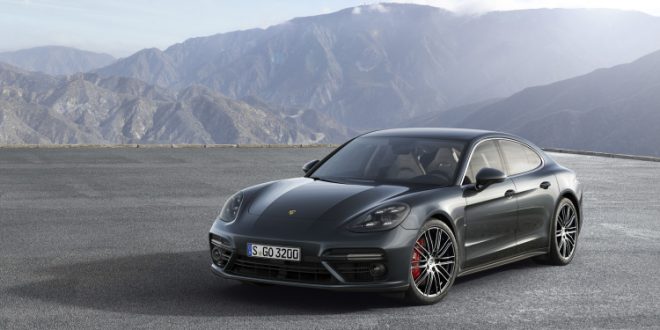According to Porsche, the new 2017 Porsche Panamera shares only three things with the previous generation: the Panamera name, the Porsche crest on the hood and the goal of being the fastest luxury sedan in the world.
The new Panamera will initially be available with three engines consisting of two Porsche designed and developed turbocharged petrol engines – a 2.9-litre V6 and a 4.0-litre V8 – and an Audi sourced 4.2-litre V8 twin-turbo diesel. A plug-in hybrid will also join the line-up early next year.
Body and Design
The new Panamera is 35mm longer at 5050mm, thanks in part to a wheelbase that has increased in length by 30mm to 2950mm. The new car is also 5mm wider at 1935mm and 5mm taller at 1423mm, although the rear roofline is 20mm lower to retain Porsche-like coupe look.
There are new bumpers, side sills, wings, roof, bonnet, rear hatch and the retractable rear spoiler is larger on both S and Turbo models. The Panamera also features a 911-esque LED light strip running between its taillights and LED matrix from headlights featuring 48 individual LEDs.
Every external body panel is made from aluminium with the single piece side wall of the car hemmed to the steel shell, a first of its kind in the automotive sector. It will be built, in its entirety including the manufacturer of the body panels and shell at Porsche’s Leipzig factory.
This new Panamera platform is a fully modular, using the VAG pioneered MSB platform, with a long wheelbase model scheduled for launch in early 2017 and a further four applications in the pipeline including a sporting brake and a coupe-SUV. The next generation Bentley Continental GT and Flying Spur and Audi A8 will also utilise the Panamera’s platform.
Engines and gearbox
Both petrol turbo charged engines are new for the Panamera, designed and developed in house by Porsche. The range of upgrades is far reaching from new construction techniques, cylinder deactivation for the V8 and injection system for the V6 and a new exhaust system for all models.
A feature of both the petrol and the V8 twin-turbo diesel engine is the positioning of the turbochargers within the centre V of the engine, between opposing banks of cylinders to improve throttle response, torque delivery and reduce emissions. Porsche didn’t feel the need to use electric turbos as the regular units delivered the performance targets required. Expect them on the face-lift model in four years time.
The new 4-litre V8 is a modular engine (the V6 is the same unit but with two-fewer cylinders) and will be made available to other brands within the VW Group. To this end, expect it to appear in the new Bentley Continental GT and Flying Spur and Audi’s top end models, such as the next RS6 and RS7 and A8 models. It will also be used in the all-new Cayenne.
Both the petrol engines use twin-scroll turbos that work in unison, while the V8 diesel’s turbos (a Euro6 compliant version of the same engine found in the Cayenne S Diesel) are sequential, with the second turbo only active at engine speeds above 2700rpm.
The new 2.9-litre V6 produces 434bhp at 5560rpm and 406lb ft between 1750 and 5500rpm, up from 414bhp at 6000rpm and 383lb ft at 1750rpm. The revised, smaller capacity 4.0-litre twin-turbo V8 (down from 4.8-litres) now produces 542bhp at 5750rpm (up from 512bhp at 6000rpm) and 563lb ft from 1960 through to 4500rpm (up from 516lb ft at 2250-4500rpm). The V8 diesel produces 416bhp at 3500rpm and 627lb ft from 1000rpm through to 3250rpm. With a top speed of a 177mph it will also be the world’s fastest diesel production car.
Performance has improved across the board for all new Panamera models, with the 2.9-litre 4S reaching 62mph in 4.4sec and topping 180mph, the 4S Diesel will crack 0-62mph in 4.5sec and the Turbo will complete the benchmark sprint in 3.8sec and top 190mph.
Also new to the Panamera is an eight-speed PDK double-clutch gearbox. Developed in conjunction with ZF, the unit has six conventional gears with the seventh and eighth used as overdrive gears. Transmission losses have been reduced by 28 per cent over the old seven-speed unit and it now features four-shafts instead of two and the latest shift-by-wire technology. The shift speeds in Sport Plus mode are on a par with those in a 991 GT3.
Agencies/Canadajournal
 Canada Journal – News of the World Articles and videos to bring you the biggest Canadian news stories from across the country every day
Canada Journal – News of the World Articles and videos to bring you the biggest Canadian news stories from across the country every day



